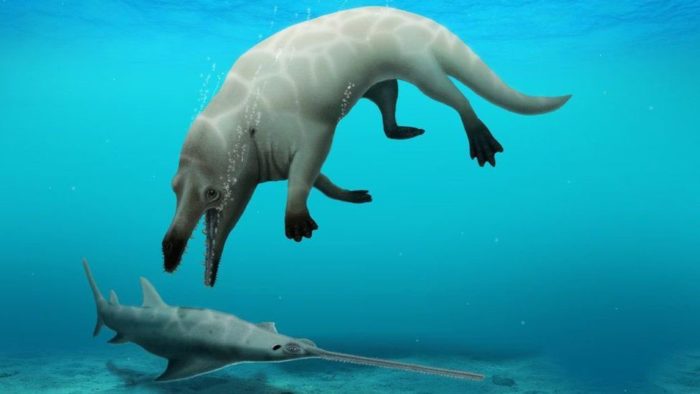Aug 30 2021
Four-Legged Whale Described
 In 1985 Michael Denton, arguing against the fact of evolution, made the following observation:
In 1985 Michael Denton, arguing against the fact of evolution, made the following observation:
“…to postulate a large number of entirely extinct hypothetical species starting from a small, relatively unspecialized land mammal and leading successively through an otter-like state, seal-like stage, sirenian-like stage and finally to a putative organism which could serve as the ancestor of the modern whales. Even from the hypothetical whale ancestor stage we need to postulate many hypothetical primitive whales to bridge the not inconsiderable gaps which separate the modern filter feeders (baleen whales) and the toothed whales.”
Denton (1985) Evolution: A Theory in Crisis, Adler & Adler Publishers:Chevy Chase, MD. p. 174
In 1992 creationist Duane Gish made an even more bold statement:
“The marine mammals abruptly appear in the fossil record as whales, dolphins, sea-cows, etc. There simply are no transitional forms in the fossil record between the marine mammals and their supposed land mammal ancestors.”
Duane Gish (1992), Evolution: The Challenge of the Fossil Record. Creation-Life Publishers: El Cajon, CA. p. 79
This remains a common strategy for creationists – point to current gaps in the fossil record and then pretend this is a problem for evolutionary theory. The unstated major premise here is that if evolution were true, we would by necessity already possess a fairly complete fossil record for the evolution of every single extant species, or at least (arbitrarily defined) major group. This premise is simply false. We have fossil windows into a process that occurred over 600 million years (if we talk only about multicellular creatures), all over the world, involving an estimated 5 billion species. There are gaps and always will be gaps.
The other mistake these and other creationists (using the term generally for convenience, to refer to those who deny evolution to some degree in favor of some sort of special creation) are making is falsely assuming that any current gap is permanent. A more scientific approach to evaluating the fossil record, or any line of evidence, is looking at how it changes over time. Specifically does it favor or falsify any particular theory? In this case evolutionary theory, the part that deals with common descent, predicts that as we find more fossil species they will generally fit into an overall pattern of nested hierarchies. Evolutionary theory does not predict any particular path and there are many possible patterns, but it does require that the fossil record fits into an overall evolutionary sequence. As one scientist put it – no horses in the Cambrian.
For example, we would not expect sudden morphological changes without any plausible mechanism. We shouldn’t find mammals with feathers, or vertebrates with eight limbs. Evolution works with what it has, and cannot go “back” (phylogenetically speaking) in order to redesign fundamental aspects of morphology. So we expect to see a plausible evolutionary sequence in the proper temporal sequence. We also expect that over time the map of the evolutionary tree of life will expand, but at the same time will fill in. Just by chance, as we find more and more fossils, many of them should be filling in existing gaps in the record.
With respect to whales, evolutionary theory does make a specific prediction – that we may find fossils of species that are morphologically transitional between land mammals and modern whales. There is no particular reason for such creatures to exist if creationism is true, but they must exist if evolution is true. That doesn’t mean we will necessarily find any particular transitional species, but given the number of opportunities we should be finding them on a regular basis.
Well, it’s 36 years after Denton’s challenge and almost 30 years after Gish’s bold statement (which was wrong at the time he said it). In this period paleontologists have discovered locations dating to a time and place where whale evolution was occurring, resulting in a wealth of whale transitional species. There are plenty of resources summarizing the evidence. It’s actually a lovely sequence. It’s not linear, because evolution is a branching process, but over time we can see the gradual shrinking of the legs, flattening of the tale, moving of the nostrils back toward the top of the head, and increase in size. You really couldn’t ask for a better evolutionary sequence. We even have specimens filling in Denton’s gaps between baleen whales and toothed whales.
Now we can add one more specimen to the growing list – a four-legged proto-whale found in Egypt. Technically a “protocetid,” Phiomicetus anubis is about 43 million years old, so it is also from the evolutionarily correct time period. Whales began their transition to the water about 50 million years ago, and by 40 million years we had protocetids, with more modern whales appearing only later in the fossil record. Whale evolution primarily took place in the seas that are now in Southeast Asia. This specimen from Africa represents a branch that migrated there, and shows some differences in morphological detail. These likely represent a more “raptorial feeding style.”
Of course all this new evidence over the last few decades has not changed the minds of many creationists. On Creation.com they still quote a scientist from 1962 saying there are no transitional fossils. They then proceed to make silly objections to many of the prominent fossil whale species, again pointing to what we don’t know as if it calls into question what we do know. Some of the claims are just anatomically ridiculous, and shows they are just riffing in order to manufacture doubt and confusion.
Forty years ago we did lack any transitional fossil whale species. Today we have a wealth of such fossils – because evolution is true.






